Economic Principles and Decision Making
VerifiedAdded on 2023/06/14
|16
|4007
|132
AI Summary
This report summarizes the market analysis for Schmeckt Gut's Besser energy bars in Atollia. The report includes projections on income, inflation, and tariff rates, and their impact on demand. The multiple regression model is used to determine the potential demand for energy bars based on income, tariff rate, and number of stores.
Contribute Materials
Your contribution can guide someone’s learning journey. Share your
documents today.
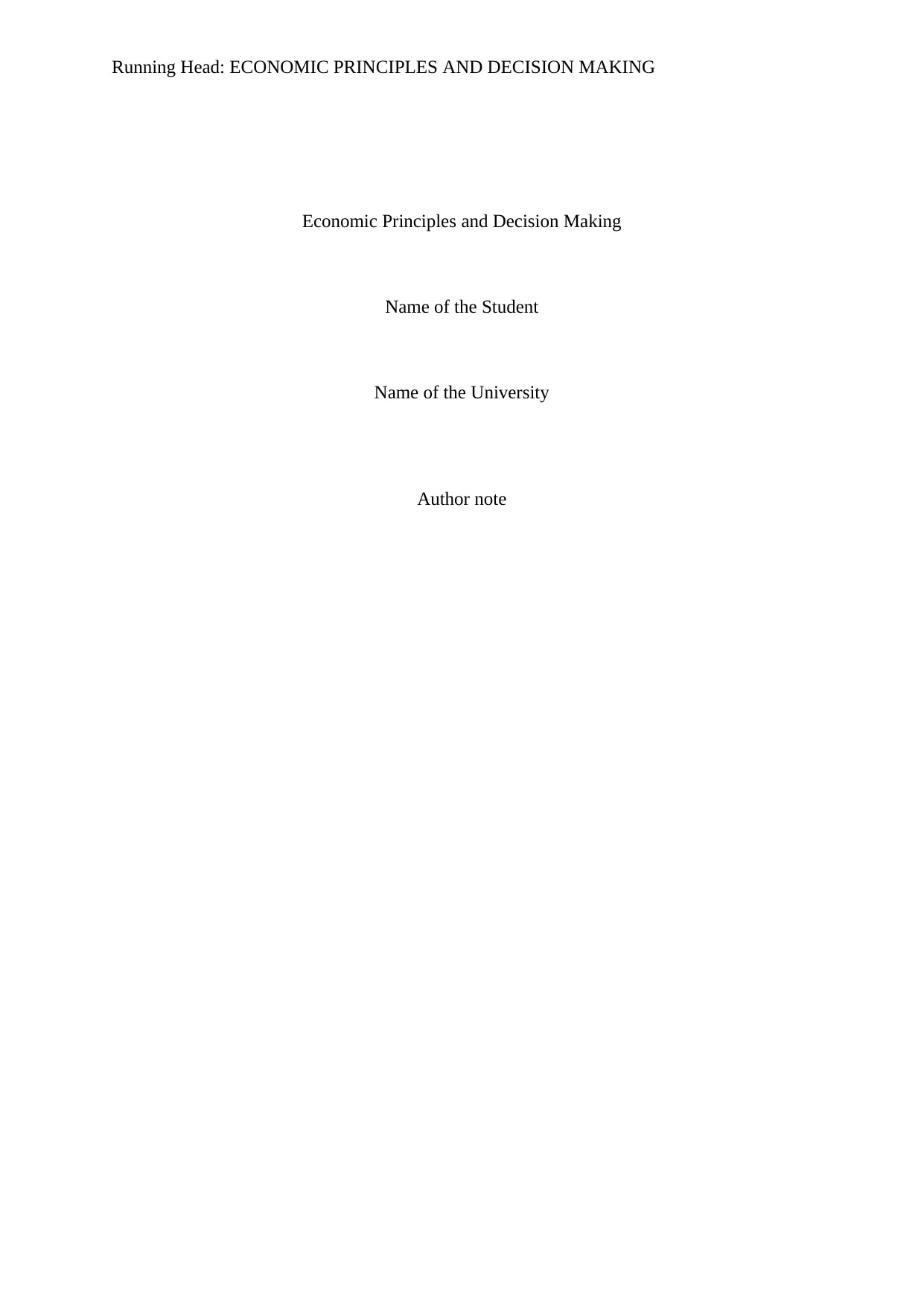
Running Head: ECONOMIC PRINCIPLES AND DECISION MAKING
Economic Principles and Decision Making
Name of the Student
Name of the University
Author note
Economic Principles and Decision Making
Name of the Student
Name of the University
Author note
Secure Best Marks with AI Grader
Need help grading? Try our AI Grader for instant feedback on your assignments.

1ECONOMIC PRINCIPLES AND DECISION MAKING
Executive Summary
Business organizations often considers entering in a new market if it seems profitable to
them. Before making entry to the new market, it is necessary to carefully scrutinize the
economic and business environment of the new market. Schmeckt Gut is planning to launch
Besser energy bars in the Atollia market. For this, the company conducts a market research
on the targeted market. A report is prepared based on this market research. Projection has
been made on different combination of income, inflation and tariff rate. The potential demand
for energy bars has a direct relation with average income while is has an opposite relation
with import tariff.
Executive Summary
Business organizations often considers entering in a new market if it seems profitable to
them. Before making entry to the new market, it is necessary to carefully scrutinize the
economic and business environment of the new market. Schmeckt Gut is planning to launch
Besser energy bars in the Atollia market. For this, the company conducts a market research
on the targeted market. A report is prepared based on this market research. Projection has
been made on different combination of income, inflation and tariff rate. The potential demand
for energy bars has a direct relation with average income while is has an opposite relation
with import tariff.
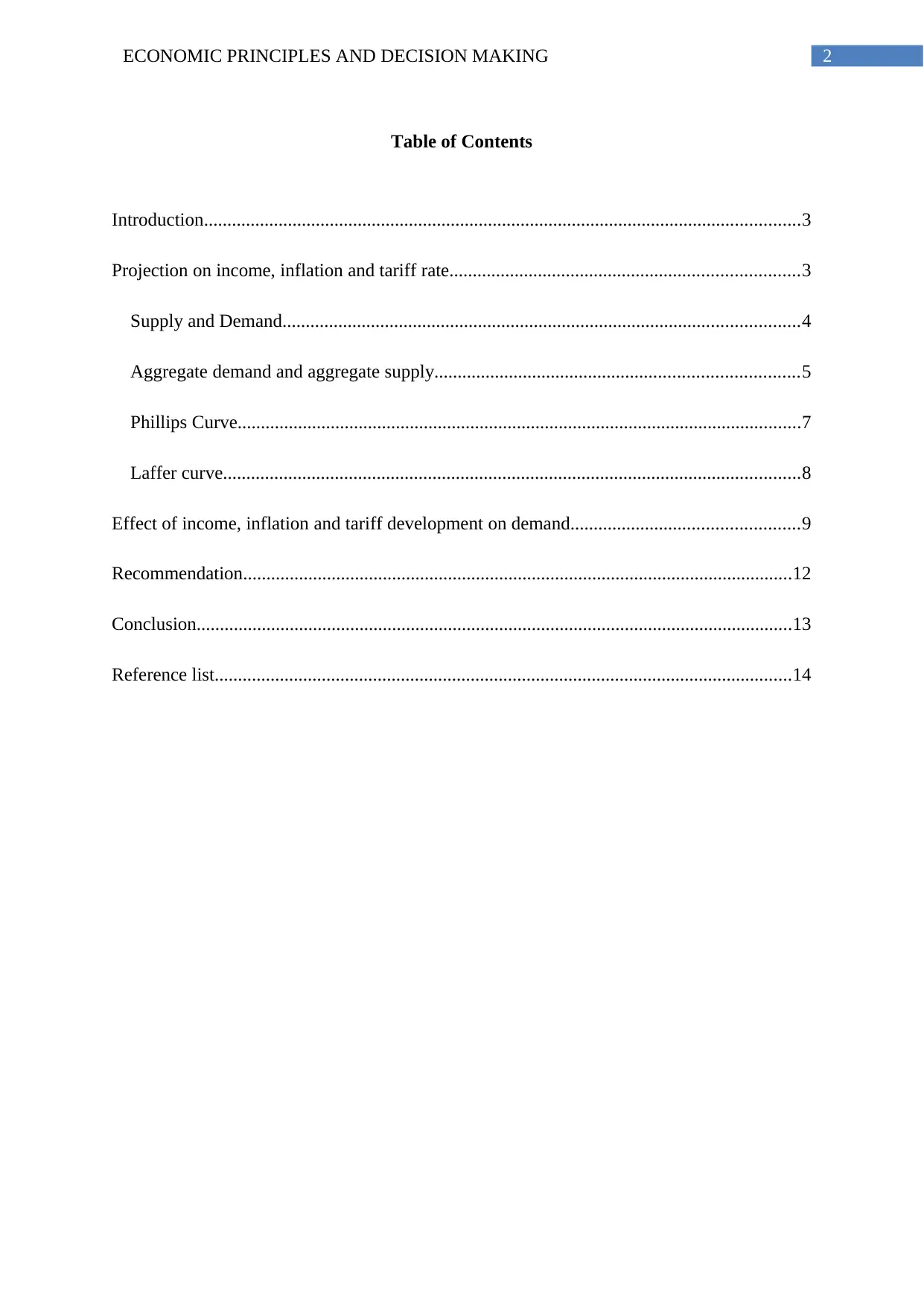
2ECONOMIC PRINCIPLES AND DECISION MAKING
Table of Contents
Introduction................................................................................................................................3
Projection on income, inflation and tariff rate...........................................................................3
Supply and Demand...............................................................................................................4
Aggregate demand and aggregate supply..............................................................................5
Phillips Curve.........................................................................................................................7
Laffer curve............................................................................................................................8
Effect of income, inflation and tariff development on demand.................................................9
Recommendation......................................................................................................................12
Conclusion................................................................................................................................13
Reference list............................................................................................................................14
Table of Contents
Introduction................................................................................................................................3
Projection on income, inflation and tariff rate...........................................................................3
Supply and Demand...............................................................................................................4
Aggregate demand and aggregate supply..............................................................................5
Phillips Curve.........................................................................................................................7
Laffer curve............................................................................................................................8
Effect of income, inflation and tariff development on demand.................................................9
Recommendation......................................................................................................................12
Conclusion................................................................................................................................13
Reference list............................................................................................................................14
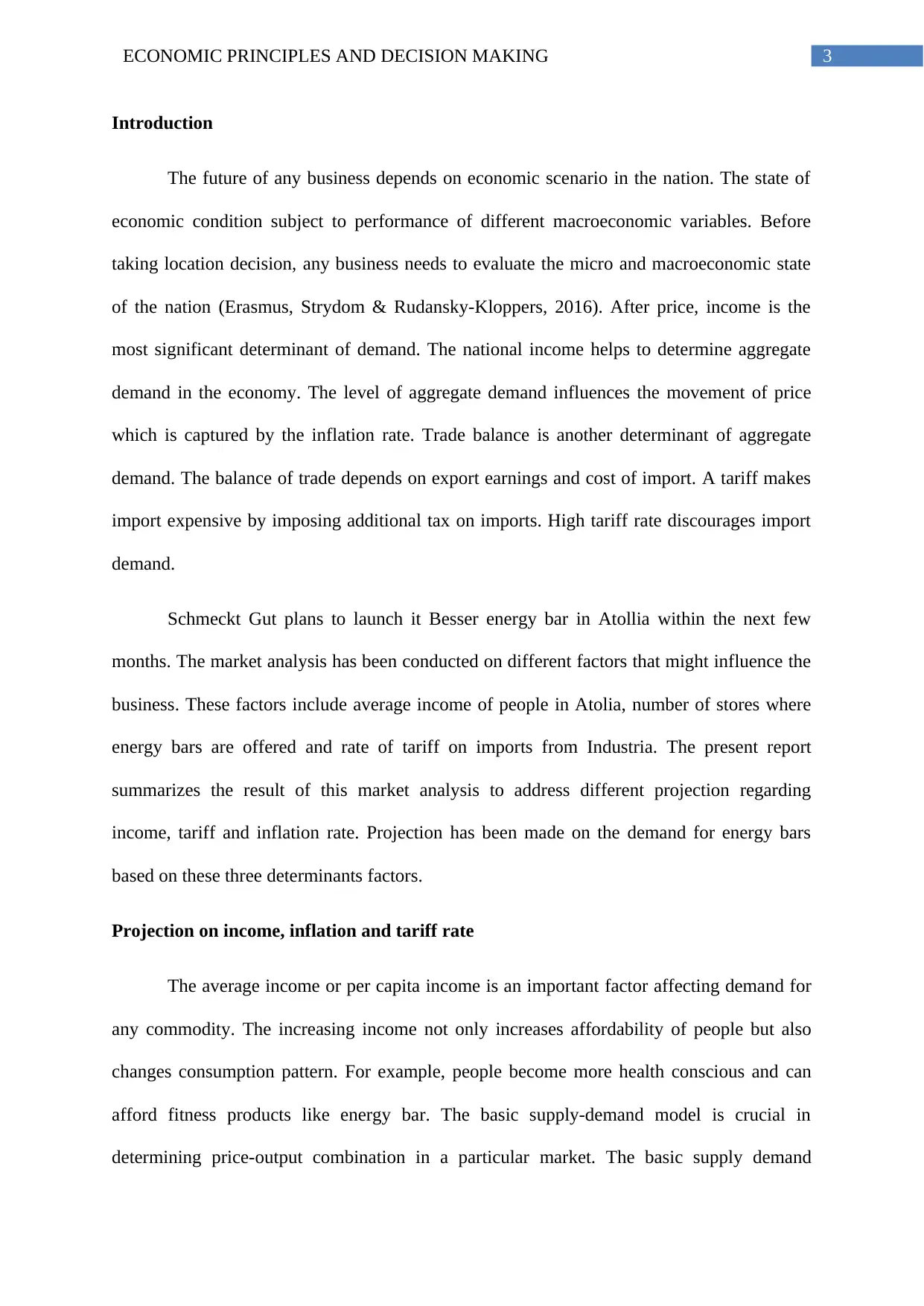
3ECONOMIC PRINCIPLES AND DECISION MAKING
Introduction
The future of any business depends on economic scenario in the nation. The state of
economic condition subject to performance of different macroeconomic variables. Before
taking location decision, any business needs to evaluate the micro and macroeconomic state
of the nation (Erasmus, Strydom & Rudansky-Kloppers, 2016). After price, income is the
most significant determinant of demand. The national income helps to determine aggregate
demand in the economy. The level of aggregate demand influences the movement of price
which is captured by the inflation rate. Trade balance is another determinant of aggregate
demand. The balance of trade depends on export earnings and cost of import. A tariff makes
import expensive by imposing additional tax on imports. High tariff rate discourages import
demand.
Schmeckt Gut plans to launch it Besser energy bar in Atollia within the next few
months. The market analysis has been conducted on different factors that might influence the
business. These factors include average income of people in Atolia, number of stores where
energy bars are offered and rate of tariff on imports from Industria. The present report
summarizes the result of this market analysis to address different projection regarding
income, tariff and inflation rate. Projection has been made on the demand for energy bars
based on these three determinants factors.
Projection on income, inflation and tariff rate
The average income or per capita income is an important factor affecting demand for
any commodity. The increasing income not only increases affordability of people but also
changes consumption pattern. For example, people become more health conscious and can
afford fitness products like energy bar. The basic supply-demand model is crucial in
determining price-output combination in a particular market. The basic supply demand
Introduction
The future of any business depends on economic scenario in the nation. The state of
economic condition subject to performance of different macroeconomic variables. Before
taking location decision, any business needs to evaluate the micro and macroeconomic state
of the nation (Erasmus, Strydom & Rudansky-Kloppers, 2016). After price, income is the
most significant determinant of demand. The national income helps to determine aggregate
demand in the economy. The level of aggregate demand influences the movement of price
which is captured by the inflation rate. Trade balance is another determinant of aggregate
demand. The balance of trade depends on export earnings and cost of import. A tariff makes
import expensive by imposing additional tax on imports. High tariff rate discourages import
demand.
Schmeckt Gut plans to launch it Besser energy bar in Atollia within the next few
months. The market analysis has been conducted on different factors that might influence the
business. These factors include average income of people in Atolia, number of stores where
energy bars are offered and rate of tariff on imports from Industria. The present report
summarizes the result of this market analysis to address different projection regarding
income, tariff and inflation rate. Projection has been made on the demand for energy bars
based on these three determinants factors.
Projection on income, inflation and tariff rate
The average income or per capita income is an important factor affecting demand for
any commodity. The increasing income not only increases affordability of people but also
changes consumption pattern. For example, people become more health conscious and can
afford fitness products like energy bar. The basic supply-demand model is crucial in
determining price-output combination in a particular market. The basic supply demand
Secure Best Marks with AI Grader
Need help grading? Try our AI Grader for instant feedback on your assignments.
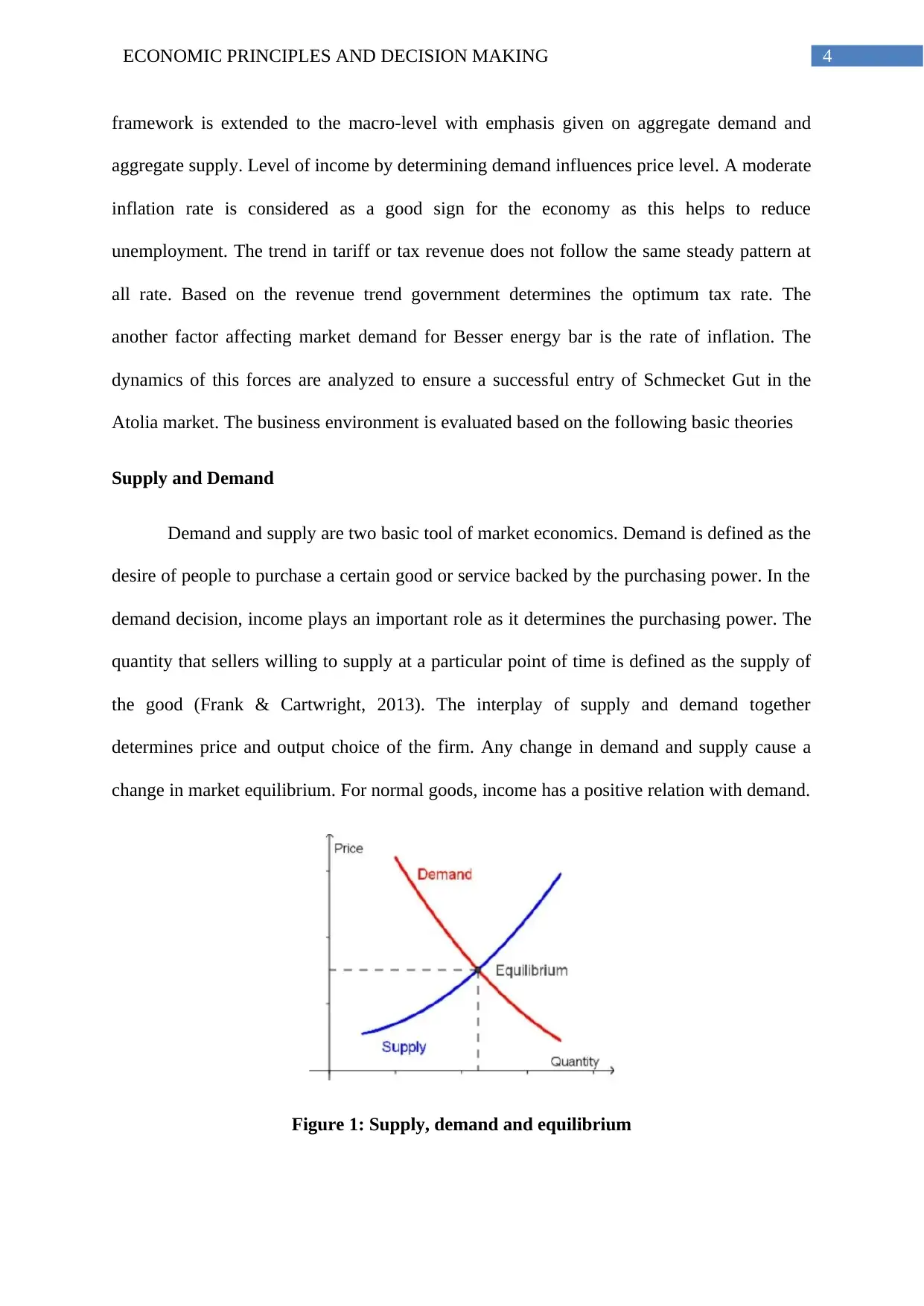
4ECONOMIC PRINCIPLES AND DECISION MAKING
framework is extended to the macro-level with emphasis given on aggregate demand and
aggregate supply. Level of income by determining demand influences price level. A moderate
inflation rate is considered as a good sign for the economy as this helps to reduce
unemployment. The trend in tariff or tax revenue does not follow the same steady pattern at
all rate. Based on the revenue trend government determines the optimum tax rate. The
another factor affecting market demand for Besser energy bar is the rate of inflation. The
dynamics of this forces are analyzed to ensure a successful entry of Schmecket Gut in the
Atolia market. The business environment is evaluated based on the following basic theories
Supply and Demand
Demand and supply are two basic tool of market economics. Demand is defined as the
desire of people to purchase a certain good or service backed by the purchasing power. In the
demand decision, income plays an important role as it determines the purchasing power. The
quantity that sellers willing to supply at a particular point of time is defined as the supply of
the good (Frank & Cartwright, 2013). The interplay of supply and demand together
determines price and output choice of the firm. Any change in demand and supply cause a
change in market equilibrium. For normal goods, income has a positive relation with demand.
Figure 1: Supply, demand and equilibrium
framework is extended to the macro-level with emphasis given on aggregate demand and
aggregate supply. Level of income by determining demand influences price level. A moderate
inflation rate is considered as a good sign for the economy as this helps to reduce
unemployment. The trend in tariff or tax revenue does not follow the same steady pattern at
all rate. Based on the revenue trend government determines the optimum tax rate. The
another factor affecting market demand for Besser energy bar is the rate of inflation. The
dynamics of this forces are analyzed to ensure a successful entry of Schmecket Gut in the
Atolia market. The business environment is evaluated based on the following basic theories
Supply and Demand
Demand and supply are two basic tool of market economics. Demand is defined as the
desire of people to purchase a certain good or service backed by the purchasing power. In the
demand decision, income plays an important role as it determines the purchasing power. The
quantity that sellers willing to supply at a particular point of time is defined as the supply of
the good (Frank & Cartwright, 2013). The interplay of supply and demand together
determines price and output choice of the firm. Any change in demand and supply cause a
change in market equilibrium. For normal goods, income has a positive relation with demand.
Figure 1: Supply, demand and equilibrium

5ECONOMIC PRINCIPLES AND DECISION MAKING
(Source: Hildenbrand, 2014)
When income changes then both domestic and foreign firms are benefitted from
increased demand. The increased income in the domestic economy makes the domestic
market attractive foreign firms (Mahanty, 2014). A rise income allows people to lead a better
quality life. People can then afford healthy habits. In order to stay physically fit and healthy
people may join gym. An increasing income in Atollia thus have a tendency to courage
people to join a gym. The physical workout at gyms have to be supplemented by energy
product as a substitute of main course meal. Energy bars are products that supplements
energy. The energy is however expensive than regular meals.
The desire of people to improve quality of their living increases demand for energy
bars. The rising trend of demand in the Atollia market provides Schmeckt Gut a ready market
for successfully launching Besser energy bars. The collected market data revealed an upward
trend in the average income, which is expected to have a positive impact on demand for
energy bars. The increasing trend of income by increasing demand causes general price level
to increase. If the inflation rate is moderate, then it is a good sign for the economy. The
increased price given cost increases profit of the sellers (Frank & Cartwright, 2013). The
inflation rate thus encourages suppliers to supply more. The moderate inflation rate offers a
favorable business environment for both domestic and foreign suppliers. Increased supply of
foreign goods often hurts the domestic suppliers by undercutting their market share.
Government then intervenes in by imposing tariff on the imported goods. Tariff apart from
restricting import provides an additional source of revenue.
Aggregate demand and aggregate supply
The study of aggregate demand and aggregate supply helps to determine the state of
macroeconomic equilibrium. Individual demand and supply depicts the scenario of an
individual market. In order to understand the demand supply condition for the economy as a
(Source: Hildenbrand, 2014)
When income changes then both domestic and foreign firms are benefitted from
increased demand. The increased income in the domestic economy makes the domestic
market attractive foreign firms (Mahanty, 2014). A rise income allows people to lead a better
quality life. People can then afford healthy habits. In order to stay physically fit and healthy
people may join gym. An increasing income in Atollia thus have a tendency to courage
people to join a gym. The physical workout at gyms have to be supplemented by energy
product as a substitute of main course meal. Energy bars are products that supplements
energy. The energy is however expensive than regular meals.
The desire of people to improve quality of their living increases demand for energy
bars. The rising trend of demand in the Atollia market provides Schmeckt Gut a ready market
for successfully launching Besser energy bars. The collected market data revealed an upward
trend in the average income, which is expected to have a positive impact on demand for
energy bars. The increasing trend of income by increasing demand causes general price level
to increase. If the inflation rate is moderate, then it is a good sign for the economy. The
increased price given cost increases profit of the sellers (Frank & Cartwright, 2013). The
inflation rate thus encourages suppliers to supply more. The moderate inflation rate offers a
favorable business environment for both domestic and foreign suppliers. Increased supply of
foreign goods often hurts the domestic suppliers by undercutting their market share.
Government then intervenes in by imposing tariff on the imported goods. Tariff apart from
restricting import provides an additional source of revenue.
Aggregate demand and aggregate supply
The study of aggregate demand and aggregate supply helps to determine the state of
macroeconomic equilibrium. Individual demand and supply depicts the scenario of an
individual market. In order to understand the demand supply condition for the economy as a
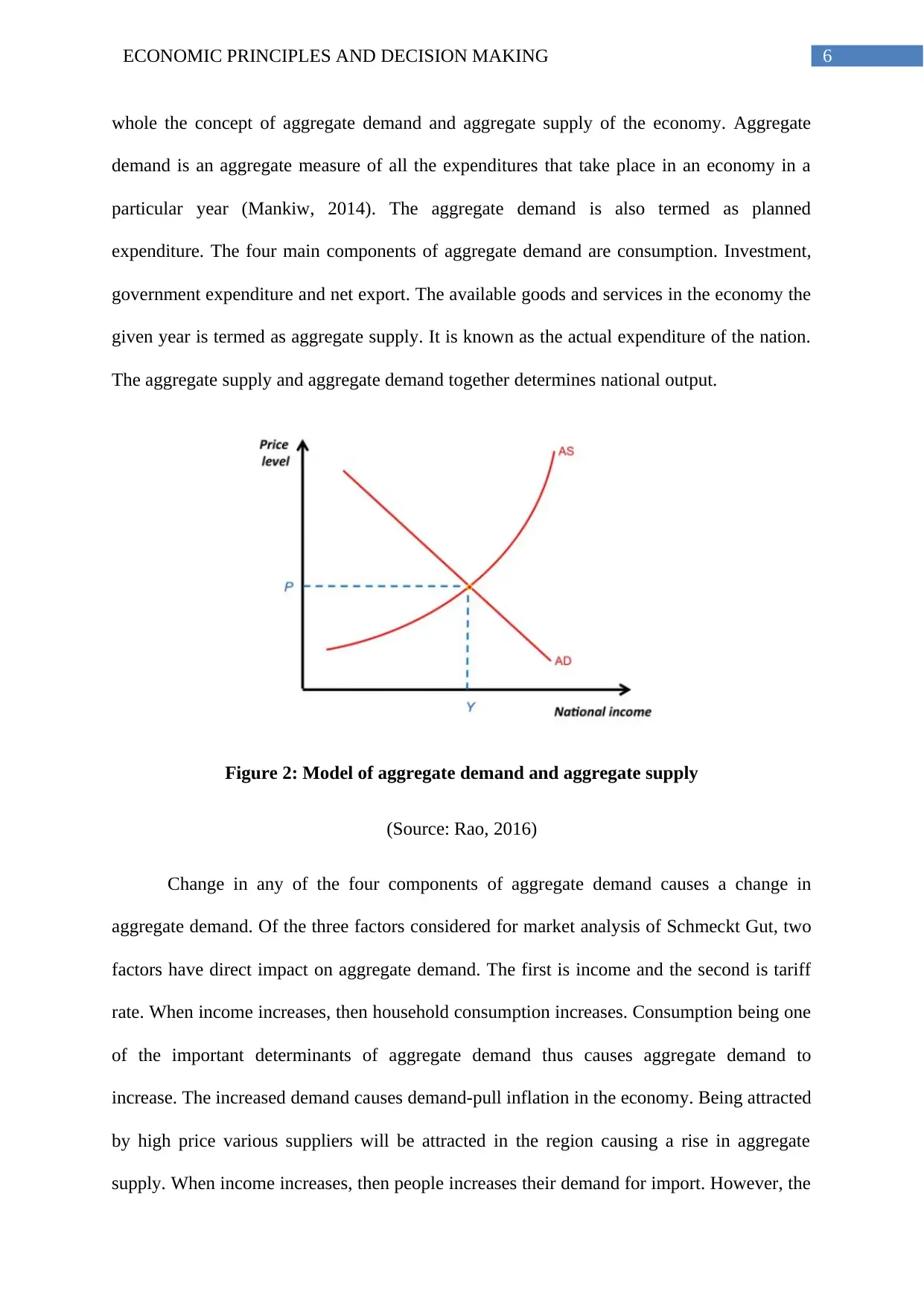
6ECONOMIC PRINCIPLES AND DECISION MAKING
whole the concept of aggregate demand and aggregate supply of the economy. Aggregate
demand is an aggregate measure of all the expenditures that take place in an economy in a
particular year (Mankiw, 2014). The aggregate demand is also termed as planned
expenditure. The four main components of aggregate demand are consumption. Investment,
government expenditure and net export. The available goods and services in the economy the
given year is termed as aggregate supply. It is known as the actual expenditure of the nation.
The aggregate supply and aggregate demand together determines national output.
Figure 2: Model of aggregate demand and aggregate supply
(Source: Rao, 2016)
Change in any of the four components of aggregate demand causes a change in
aggregate demand. Of the three factors considered for market analysis of Schmeckt Gut, two
factors have direct impact on aggregate demand. The first is income and the second is tariff
rate. When income increases, then household consumption increases. Consumption being one
of the important determinants of aggregate demand thus causes aggregate demand to
increase. The increased demand causes demand-pull inflation in the economy. Being attracted
by high price various suppliers will be attracted in the region causing a rise in aggregate
supply. When income increases, then people increases their demand for import. However, the
whole the concept of aggregate demand and aggregate supply of the economy. Aggregate
demand is an aggregate measure of all the expenditures that take place in an economy in a
particular year (Mankiw, 2014). The aggregate demand is also termed as planned
expenditure. The four main components of aggregate demand are consumption. Investment,
government expenditure and net export. The available goods and services in the economy the
given year is termed as aggregate supply. It is known as the actual expenditure of the nation.
The aggregate supply and aggregate demand together determines national output.
Figure 2: Model of aggregate demand and aggregate supply
(Source: Rao, 2016)
Change in any of the four components of aggregate demand causes a change in
aggregate demand. Of the three factors considered for market analysis of Schmeckt Gut, two
factors have direct impact on aggregate demand. The first is income and the second is tariff
rate. When income increases, then household consumption increases. Consumption being one
of the important determinants of aggregate demand thus causes aggregate demand to
increase. The increased demand causes demand-pull inflation in the economy. Being attracted
by high price various suppliers will be attracted in the region causing a rise in aggregate
supply. When income increases, then people increases their demand for import. However, the
Paraphrase This Document
Need a fresh take? Get an instant paraphrase of this document with our AI Paraphraser
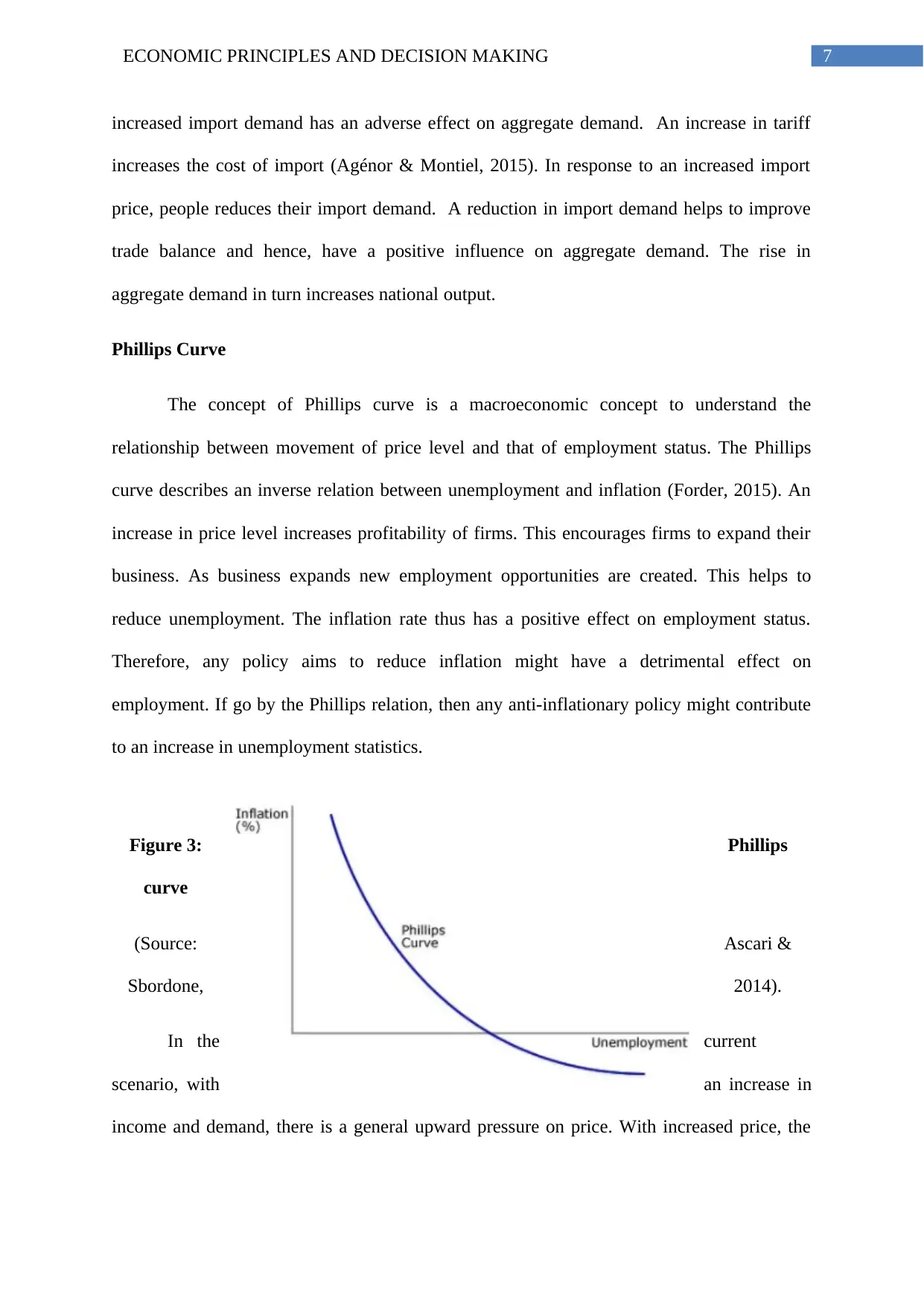
7ECONOMIC PRINCIPLES AND DECISION MAKING
increased import demand has an adverse effect on aggregate demand. An increase in tariff
increases the cost of import (Agénor & Montiel, 2015). In response to an increased import
price, people reduces their import demand. A reduction in import demand helps to improve
trade balance and hence, have a positive influence on aggregate demand. The rise in
aggregate demand in turn increases national output.
Phillips Curve
The concept of Phillips curve is a macroeconomic concept to understand the
relationship between movement of price level and that of employment status. The Phillips
curve describes an inverse relation between unemployment and inflation (Forder, 2015). An
increase in price level increases profitability of firms. This encourages firms to expand their
business. As business expands new employment opportunities are created. This helps to
reduce unemployment. The inflation rate thus has a positive effect on employment status.
Therefore, any policy aims to reduce inflation might have a detrimental effect on
employment. If go by the Phillips relation, then any anti-inflationary policy might contribute
to an increase in unemployment statistics.
Figure 3: Phillips
curve
(Source: Ascari &
Sbordone, 2014).
In the current
scenario, with an increase in
income and demand, there is a general upward pressure on price. With increased price, the
increased import demand has an adverse effect on aggregate demand. An increase in tariff
increases the cost of import (Agénor & Montiel, 2015). In response to an increased import
price, people reduces their import demand. A reduction in import demand helps to improve
trade balance and hence, have a positive influence on aggregate demand. The rise in
aggregate demand in turn increases national output.
Phillips Curve
The concept of Phillips curve is a macroeconomic concept to understand the
relationship between movement of price level and that of employment status. The Phillips
curve describes an inverse relation between unemployment and inflation (Forder, 2015). An
increase in price level increases profitability of firms. This encourages firms to expand their
business. As business expands new employment opportunities are created. This helps to
reduce unemployment. The inflation rate thus has a positive effect on employment status.
Therefore, any policy aims to reduce inflation might have a detrimental effect on
employment. If go by the Phillips relation, then any anti-inflationary policy might contribute
to an increase in unemployment statistics.
Figure 3: Phillips
curve
(Source: Ascari &
Sbordone, 2014).
In the current
scenario, with an increase in
income and demand, there is a general upward pressure on price. With increased price, the
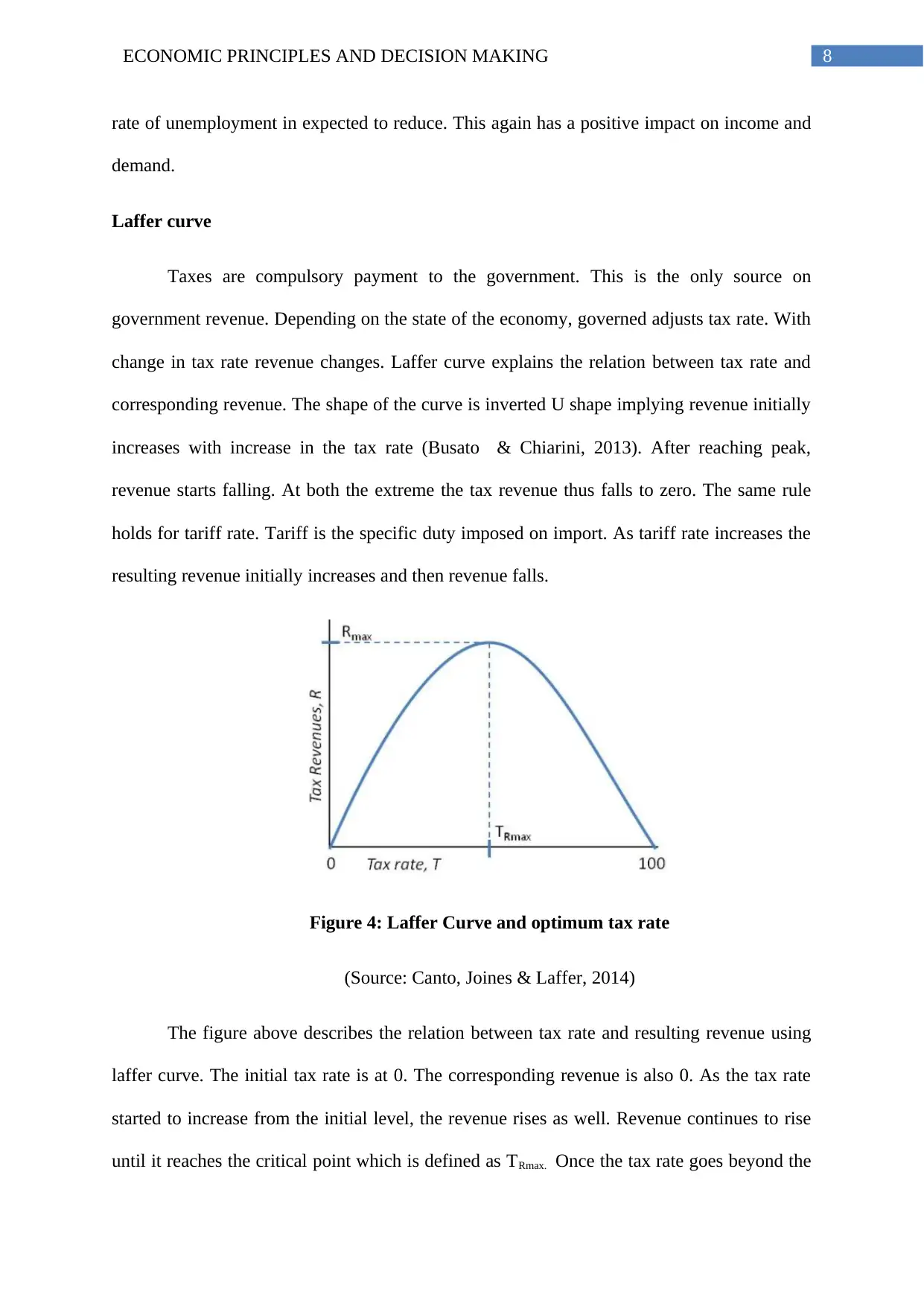
8ECONOMIC PRINCIPLES AND DECISION MAKING
rate of unemployment in expected to reduce. This again has a positive impact on income and
demand.
Laffer curve
Taxes are compulsory payment to the government. This is the only source on
government revenue. Depending on the state of the economy, governed adjusts tax rate. With
change in tax rate revenue changes. Laffer curve explains the relation between tax rate and
corresponding revenue. The shape of the curve is inverted U shape implying revenue initially
increases with increase in the tax rate (Busato & Chiarini, 2013). After reaching peak,
revenue starts falling. At both the extreme the tax revenue thus falls to zero. The same rule
holds for tariff rate. Tariff is the specific duty imposed on import. As tariff rate increases the
resulting revenue initially increases and then revenue falls.
Figure 4: Laffer Curve and optimum tax rate
(Source: Canto, Joines & Laffer, 2014)
The figure above describes the relation between tax rate and resulting revenue using
laffer curve. The initial tax rate is at 0. The corresponding revenue is also 0. As the tax rate
started to increase from the initial level, the revenue rises as well. Revenue continues to rise
until it reaches the critical point which is defined as TRmax. Once the tax rate goes beyond the
rate of unemployment in expected to reduce. This again has a positive impact on income and
demand.
Laffer curve
Taxes are compulsory payment to the government. This is the only source on
government revenue. Depending on the state of the economy, governed adjusts tax rate. With
change in tax rate revenue changes. Laffer curve explains the relation between tax rate and
corresponding revenue. The shape of the curve is inverted U shape implying revenue initially
increases with increase in the tax rate (Busato & Chiarini, 2013). After reaching peak,
revenue starts falling. At both the extreme the tax revenue thus falls to zero. The same rule
holds for tariff rate. Tariff is the specific duty imposed on import. As tariff rate increases the
resulting revenue initially increases and then revenue falls.
Figure 4: Laffer Curve and optimum tax rate
(Source: Canto, Joines & Laffer, 2014)
The figure above describes the relation between tax rate and resulting revenue using
laffer curve. The initial tax rate is at 0. The corresponding revenue is also 0. As the tax rate
started to increase from the initial level, the revenue rises as well. Revenue continues to rise
until it reaches the critical point which is defined as TRmax. Once the tax rate goes beyond the
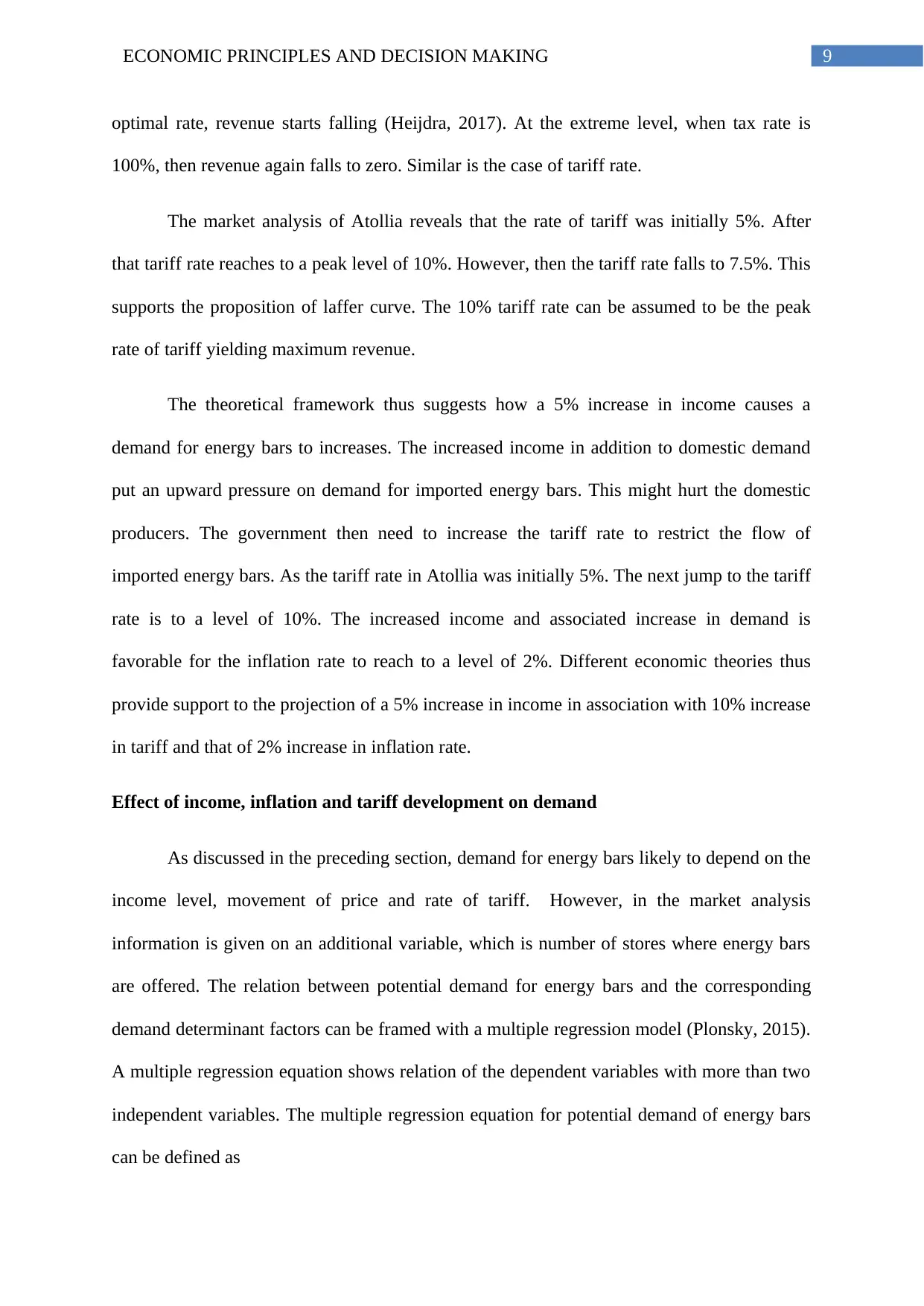
9ECONOMIC PRINCIPLES AND DECISION MAKING
optimal rate, revenue starts falling (Heijdra, 2017). At the extreme level, when tax rate is
100%, then revenue again falls to zero. Similar is the case of tariff rate.
The market analysis of Atollia reveals that the rate of tariff was initially 5%. After
that tariff rate reaches to a peak level of 10%. However, then the tariff rate falls to 7.5%. This
supports the proposition of laffer curve. The 10% tariff rate can be assumed to be the peak
rate of tariff yielding maximum revenue.
The theoretical framework thus suggests how a 5% increase in income causes a
demand for energy bars to increases. The increased income in addition to domestic demand
put an upward pressure on demand for imported energy bars. This might hurt the domestic
producers. The government then need to increase the tariff rate to restrict the flow of
imported energy bars. As the tariff rate in Atollia was initially 5%. The next jump to the tariff
rate is to a level of 10%. The increased income and associated increase in demand is
favorable for the inflation rate to reach to a level of 2%. Different economic theories thus
provide support to the projection of a 5% increase in income in association with 10% increase
in tariff and that of 2% increase in inflation rate.
Effect of income, inflation and tariff development on demand
As discussed in the preceding section, demand for energy bars likely to depend on the
income level, movement of price and rate of tariff. However, in the market analysis
information is given on an additional variable, which is number of stores where energy bars
are offered. The relation between potential demand for energy bars and the corresponding
demand determinant factors can be framed with a multiple regression model (Plonsky, 2015).
A multiple regression equation shows relation of the dependent variables with more than two
independent variables. The multiple regression equation for potential demand of energy bars
can be defined as
optimal rate, revenue starts falling (Heijdra, 2017). At the extreme level, when tax rate is
100%, then revenue again falls to zero. Similar is the case of tariff rate.
The market analysis of Atollia reveals that the rate of tariff was initially 5%. After
that tariff rate reaches to a peak level of 10%. However, then the tariff rate falls to 7.5%. This
supports the proposition of laffer curve. The 10% tariff rate can be assumed to be the peak
rate of tariff yielding maximum revenue.
The theoretical framework thus suggests how a 5% increase in income causes a
demand for energy bars to increases. The increased income in addition to domestic demand
put an upward pressure on demand for imported energy bars. This might hurt the domestic
producers. The government then need to increase the tariff rate to restrict the flow of
imported energy bars. As the tariff rate in Atollia was initially 5%. The next jump to the tariff
rate is to a level of 10%. The increased income and associated increase in demand is
favorable for the inflation rate to reach to a level of 2%. Different economic theories thus
provide support to the projection of a 5% increase in income in association with 10% increase
in tariff and that of 2% increase in inflation rate.
Effect of income, inflation and tariff development on demand
As discussed in the preceding section, demand for energy bars likely to depend on the
income level, movement of price and rate of tariff. However, in the market analysis
information is given on an additional variable, which is number of stores where energy bars
are offered. The relation between potential demand for energy bars and the corresponding
demand determinant factors can be framed with a multiple regression model (Plonsky, 2015).
A multiple regression equation shows relation of the dependent variables with more than two
independent variables. The multiple regression equation for potential demand of energy bars
can be defined as
Secure Best Marks with AI Grader
Need help grading? Try our AI Grader for instant feedback on your assignments.
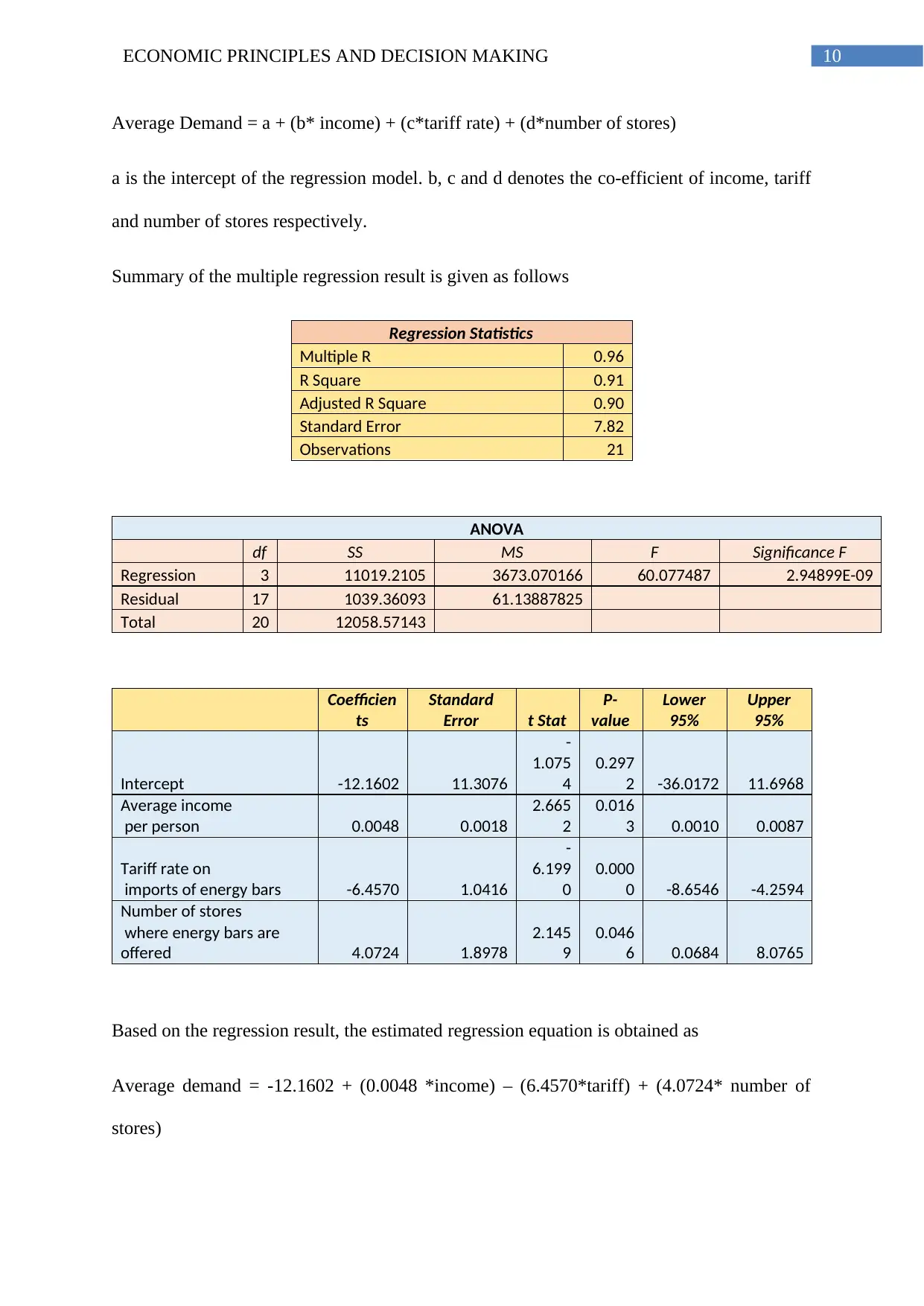
10ECONOMIC PRINCIPLES AND DECISION MAKING
Average Demand = a + (b* income) + (c*tariff rate) + (d*number of stores)
a is the intercept of the regression model. b, c and d denotes the co-efficient of income, tariff
and number of stores respectively.
Summary of the multiple regression result is given as follows
Regression Statistics
Multiple R 0.96
R Square 0.91
Adjusted R Square 0.90
Standard Error 7.82
Observations 21
ANOVA
df SS MS F Significance F
Regression 3 11019.2105 3673.070166 60.077487 2.94899E-09
Residual 17 1039.36093 61.13887825
Total 20 12058.57143
Coefficien
ts
Standard
Error t Stat
P-
value
Lower
95%
Upper
95%
Intercept -12.1602 11.3076
-
1.075
4
0.297
2 -36.0172 11.6968
Average income
per person 0.0048 0.0018
2.665
2
0.016
3 0.0010 0.0087
Tariff rate on
imports of energy bars -6.4570 1.0416
-
6.199
0
0.000
0 -8.6546 -4.2594
Number of stores
where energy bars are
offered 4.0724 1.8978
2.145
9
0.046
6 0.0684 8.0765
Based on the regression result, the estimated regression equation is obtained as
Average demand = -12.1602 + (0.0048 *income) – (6.4570*tariff) + (4.0724* number of
stores)
Average Demand = a + (b* income) + (c*tariff rate) + (d*number of stores)
a is the intercept of the regression model. b, c and d denotes the co-efficient of income, tariff
and number of stores respectively.
Summary of the multiple regression result is given as follows
Regression Statistics
Multiple R 0.96
R Square 0.91
Adjusted R Square 0.90
Standard Error 7.82
Observations 21
ANOVA
df SS MS F Significance F
Regression 3 11019.2105 3673.070166 60.077487 2.94899E-09
Residual 17 1039.36093 61.13887825
Total 20 12058.57143
Coefficien
ts
Standard
Error t Stat
P-
value
Lower
95%
Upper
95%
Intercept -12.1602 11.3076
-
1.075
4
0.297
2 -36.0172 11.6968
Average income
per person 0.0048 0.0018
2.665
2
0.016
3 0.0010 0.0087
Tariff rate on
imports of energy bars -6.4570 1.0416
-
6.199
0
0.000
0 -8.6546 -4.2594
Number of stores
where energy bars are
offered 4.0724 1.8978
2.145
9
0.046
6 0.0684 8.0765
Based on the regression result, the estimated regression equation is obtained as
Average demand = -12.1602 + (0.0048 *income) – (6.4570*tariff) + (4.0724* number of
stores)

11ECONOMIC PRINCIPLES AND DECISION MAKING
The value of R square is obtained as 0.91. The correlation co-efficient or R square
value shows the proportion of variation in the dependent variable in explained by the
independent variables together. A high value of R square indicates the concerned model is a
good fit model (Draper & Smith, 2014). Here, the value of the correlation coefficient implies
that the three independent variables together explain 91 percent variation in the potential
demand for Schmeckt Gut’s energy bar. This in turn support the claim that the three taken
independent variables have significant relevance for demand of energy bars.
The individual coefficient indicate relation between each of the variables with
demand. For average income per person, value of the co-efficient is 0.0048. The positive sign
implies the variable has a positive relation with demand. As income of people increases in
Atollia, people thus have a tendency to increase demand for energy bars and vice versa. The
relationship however is valid only when the relation between the two variables are
statistically significant (Plonsky, 2015). The p value corresponding to average income is
0.0163. The p value is less than the significance level of 0.05. This suggests the variable is
statistically significant at the 5% level of significant and hence income is a positive
significant determinant of potential demand for energy bar.
The next demand determinant factor is tariff rate. The tariff rate considered here is the
tariff rate imposed on import from Industria. The coefficient of tariff is -6.4570. The tariff
rate thus has an adverse impact on the potential demand of energy bars. The rationale behind
the relation is simple. As tariff increases, the effective price of imported energy bars
increases. This induces people to demand energy bars less. The corresponding p value for
tariff rate is 0.0000. The p value less than significance level implies like income; tariff rate is
a significant determinant of demand. Therefore, government policy decision regarding tariff
influences the market demand of Schmeckt Gut. A favorable business environment of the
company needs the government to reduce imposed tariff as minimum as possible.
The value of R square is obtained as 0.91. The correlation co-efficient or R square
value shows the proportion of variation in the dependent variable in explained by the
independent variables together. A high value of R square indicates the concerned model is a
good fit model (Draper & Smith, 2014). Here, the value of the correlation coefficient implies
that the three independent variables together explain 91 percent variation in the potential
demand for Schmeckt Gut’s energy bar. This in turn support the claim that the three taken
independent variables have significant relevance for demand of energy bars.
The individual coefficient indicate relation between each of the variables with
demand. For average income per person, value of the co-efficient is 0.0048. The positive sign
implies the variable has a positive relation with demand. As income of people increases in
Atollia, people thus have a tendency to increase demand for energy bars and vice versa. The
relationship however is valid only when the relation between the two variables are
statistically significant (Plonsky, 2015). The p value corresponding to average income is
0.0163. The p value is less than the significance level of 0.05. This suggests the variable is
statistically significant at the 5% level of significant and hence income is a positive
significant determinant of potential demand for energy bar.
The next demand determinant factor is tariff rate. The tariff rate considered here is the
tariff rate imposed on import from Industria. The coefficient of tariff is -6.4570. The tariff
rate thus has an adverse impact on the potential demand of energy bars. The rationale behind
the relation is simple. As tariff increases, the effective price of imported energy bars
increases. This induces people to demand energy bars less. The corresponding p value for
tariff rate is 0.0000. The p value less than significance level implies like income; tariff rate is
a significant determinant of demand. Therefore, government policy decision regarding tariff
influences the market demand of Schmeckt Gut. A favorable business environment of the
company needs the government to reduce imposed tariff as minimum as possible.
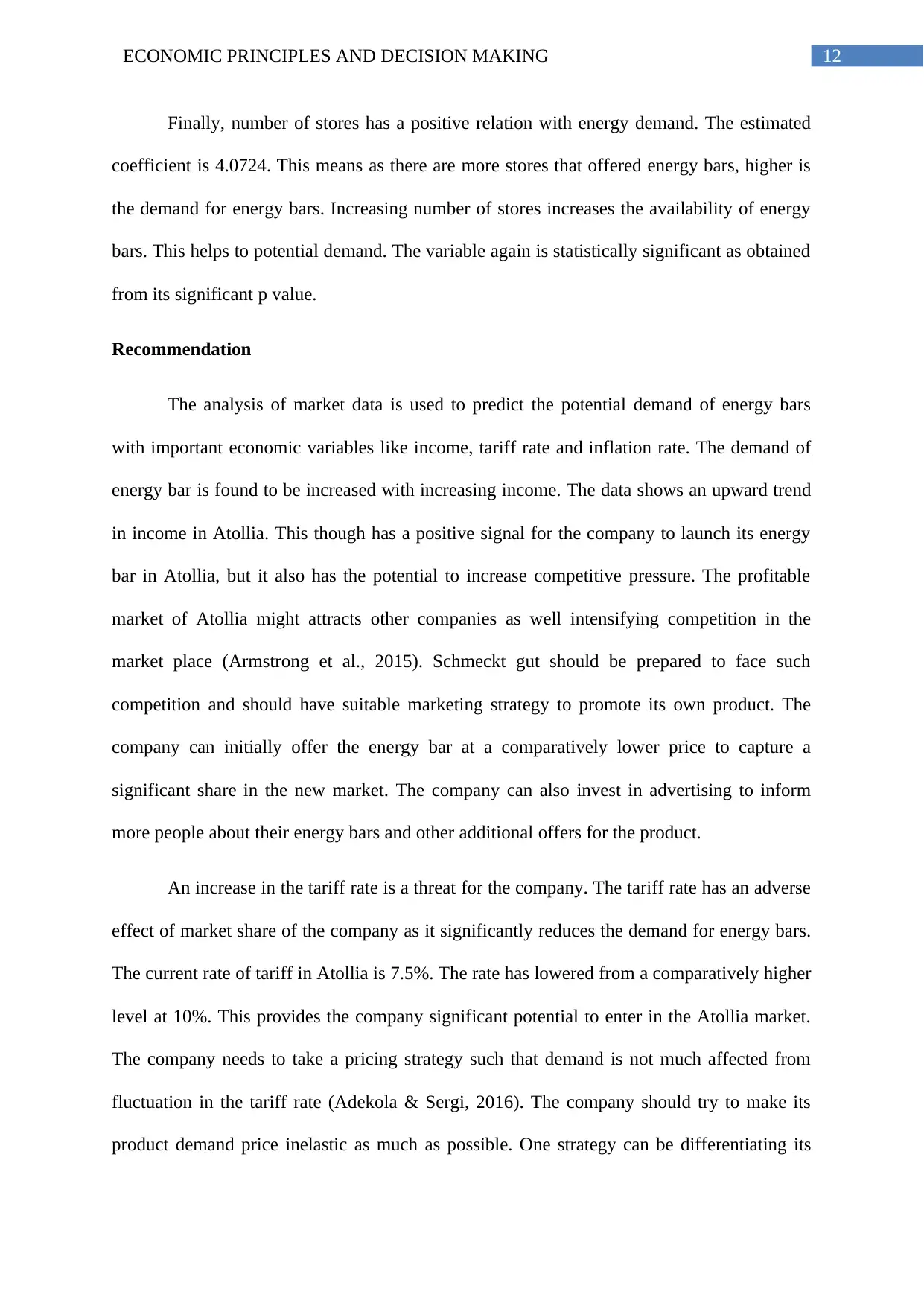
12ECONOMIC PRINCIPLES AND DECISION MAKING
Finally, number of stores has a positive relation with energy demand. The estimated
coefficient is 4.0724. This means as there are more stores that offered energy bars, higher is
the demand for energy bars. Increasing number of stores increases the availability of energy
bars. This helps to potential demand. The variable again is statistically significant as obtained
from its significant p value.
Recommendation
The analysis of market data is used to predict the potential demand of energy bars
with important economic variables like income, tariff rate and inflation rate. The demand of
energy bar is found to be increased with increasing income. The data shows an upward trend
in income in Atollia. This though has a positive signal for the company to launch its energy
bar in Atollia, but it also has the potential to increase competitive pressure. The profitable
market of Atollia might attracts other companies as well intensifying competition in the
market place (Armstrong et al., 2015). Schmeckt gut should be prepared to face such
competition and should have suitable marketing strategy to promote its own product. The
company can initially offer the energy bar at a comparatively lower price to capture a
significant share in the new market. The company can also invest in advertising to inform
more people about their energy bars and other additional offers for the product.
An increase in the tariff rate is a threat for the company. The tariff rate has an adverse
effect of market share of the company as it significantly reduces the demand for energy bars.
The current rate of tariff in Atollia is 7.5%. The rate has lowered from a comparatively higher
level at 10%. This provides the company significant potential to enter in the Atollia market.
The company needs to take a pricing strategy such that demand is not much affected from
fluctuation in the tariff rate (Adekola & Sergi, 2016). The company should try to make its
product demand price inelastic as much as possible. One strategy can be differentiating its
Finally, number of stores has a positive relation with energy demand. The estimated
coefficient is 4.0724. This means as there are more stores that offered energy bars, higher is
the demand for energy bars. Increasing number of stores increases the availability of energy
bars. This helps to potential demand. The variable again is statistically significant as obtained
from its significant p value.
Recommendation
The analysis of market data is used to predict the potential demand of energy bars
with important economic variables like income, tariff rate and inflation rate. The demand of
energy bar is found to be increased with increasing income. The data shows an upward trend
in income in Atollia. This though has a positive signal for the company to launch its energy
bar in Atollia, but it also has the potential to increase competitive pressure. The profitable
market of Atollia might attracts other companies as well intensifying competition in the
market place (Armstrong et al., 2015). Schmeckt gut should be prepared to face such
competition and should have suitable marketing strategy to promote its own product. The
company can initially offer the energy bar at a comparatively lower price to capture a
significant share in the new market. The company can also invest in advertising to inform
more people about their energy bars and other additional offers for the product.
An increase in the tariff rate is a threat for the company. The tariff rate has an adverse
effect of market share of the company as it significantly reduces the demand for energy bars.
The current rate of tariff in Atollia is 7.5%. The rate has lowered from a comparatively higher
level at 10%. This provides the company significant potential to enter in the Atollia market.
The company needs to take a pricing strategy such that demand is not much affected from
fluctuation in the tariff rate (Adekola & Sergi, 2016). The company should try to make its
product demand price inelastic as much as possible. One strategy can be differentiating its
Paraphrase This Document
Need a fresh take? Get an instant paraphrase of this document with our AI Paraphraser
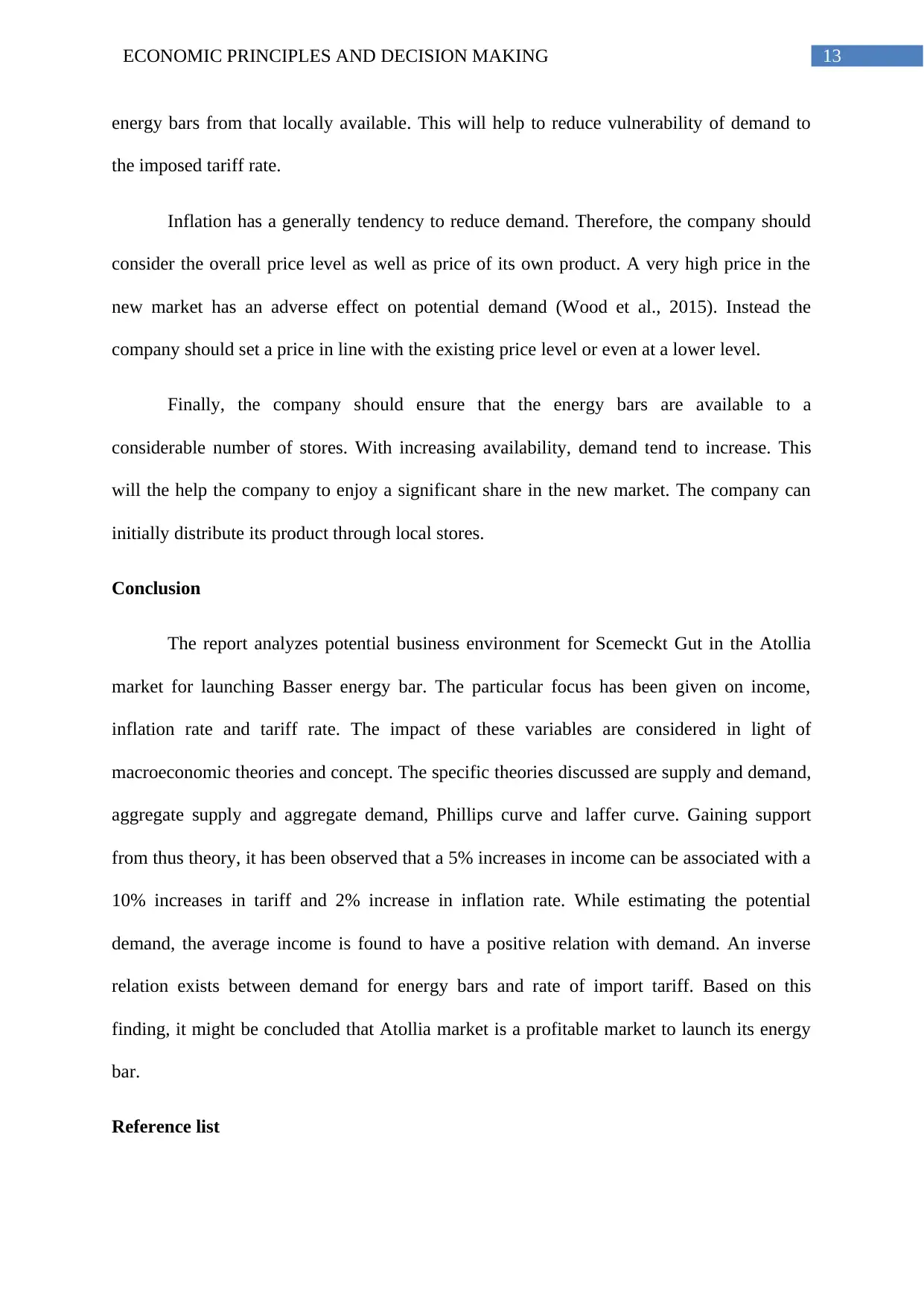
13ECONOMIC PRINCIPLES AND DECISION MAKING
energy bars from that locally available. This will help to reduce vulnerability of demand to
the imposed tariff rate.
Inflation has a generally tendency to reduce demand. Therefore, the company should
consider the overall price level as well as price of its own product. A very high price in the
new market has an adverse effect on potential demand (Wood et al., 2015). Instead the
company should set a price in line with the existing price level or even at a lower level.
Finally, the company should ensure that the energy bars are available to a
considerable number of stores. With increasing availability, demand tend to increase. This
will the help the company to enjoy a significant share in the new market. The company can
initially distribute its product through local stores.
Conclusion
The report analyzes potential business environment for Scemeckt Gut in the Atollia
market for launching Basser energy bar. The particular focus has been given on income,
inflation rate and tariff rate. The impact of these variables are considered in light of
macroeconomic theories and concept. The specific theories discussed are supply and demand,
aggregate supply and aggregate demand, Phillips curve and laffer curve. Gaining support
from thus theory, it has been observed that a 5% increases in income can be associated with a
10% increases in tariff and 2% increase in inflation rate. While estimating the potential
demand, the average income is found to have a positive relation with demand. An inverse
relation exists between demand for energy bars and rate of import tariff. Based on this
finding, it might be concluded that Atollia market is a profitable market to launch its energy
bar.
Reference list
energy bars from that locally available. This will help to reduce vulnerability of demand to
the imposed tariff rate.
Inflation has a generally tendency to reduce demand. Therefore, the company should
consider the overall price level as well as price of its own product. A very high price in the
new market has an adverse effect on potential demand (Wood et al., 2015). Instead the
company should set a price in line with the existing price level or even at a lower level.
Finally, the company should ensure that the energy bars are available to a
considerable number of stores. With increasing availability, demand tend to increase. This
will the help the company to enjoy a significant share in the new market. The company can
initially distribute its product through local stores.
Conclusion
The report analyzes potential business environment for Scemeckt Gut in the Atollia
market for launching Basser energy bar. The particular focus has been given on income,
inflation rate and tariff rate. The impact of these variables are considered in light of
macroeconomic theories and concept. The specific theories discussed are supply and demand,
aggregate supply and aggregate demand, Phillips curve and laffer curve. Gaining support
from thus theory, it has been observed that a 5% increases in income can be associated with a
10% increases in tariff and 2% increase in inflation rate. While estimating the potential
demand, the average income is found to have a positive relation with demand. An inverse
relation exists between demand for energy bars and rate of import tariff. Based on this
finding, it might be concluded that Atollia market is a profitable market to launch its energy
bar.
Reference list
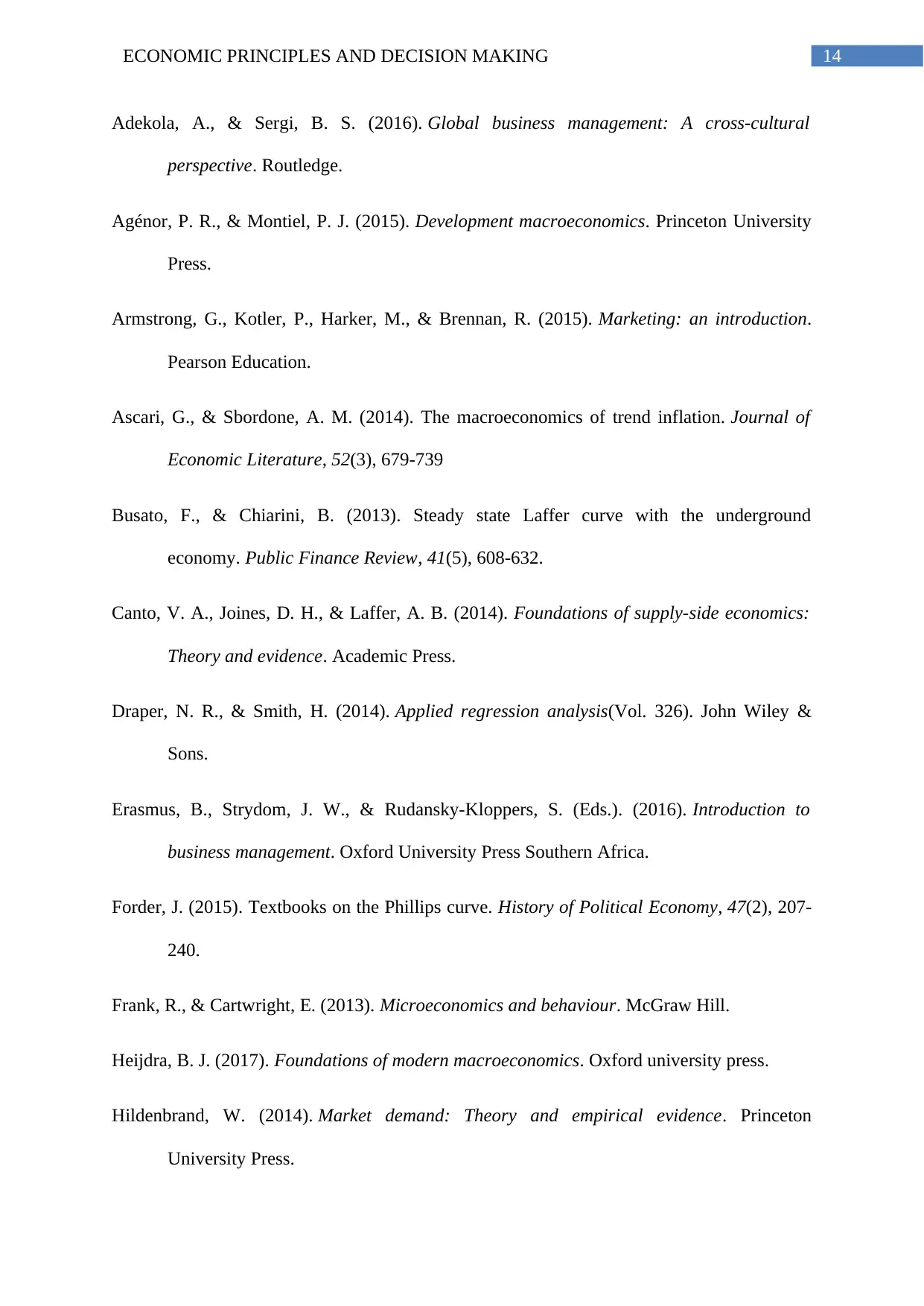
14ECONOMIC PRINCIPLES AND DECISION MAKING
Adekola, A., & Sergi, B. S. (2016). Global business management: A cross-cultural
perspective. Routledge.
Agénor, P. R., & Montiel, P. J. (2015). Development macroeconomics. Princeton University
Press.
Armstrong, G., Kotler, P., Harker, M., & Brennan, R. (2015). Marketing: an introduction.
Pearson Education.
Ascari, G., & Sbordone, A. M. (2014). The macroeconomics of trend inflation. Journal of
Economic Literature, 52(3), 679-739
Busato, F., & Chiarini, B. (2013). Steady state Laffer curve with the underground
economy. Public Finance Review, 41(5), 608-632.
Canto, V. A., Joines, D. H., & Laffer, A. B. (2014). Foundations of supply-side economics:
Theory and evidence. Academic Press.
Draper, N. R., & Smith, H. (2014). Applied regression analysis(Vol. 326). John Wiley &
Sons.
Erasmus, B., Strydom, J. W., & Rudansky-Kloppers, S. (Eds.). (2016). Introduction to
business management. Oxford University Press Southern Africa.
Forder, J. (2015). Textbooks on the Phillips curve. History of Political Economy, 47(2), 207-
240.
Frank, R., & Cartwright, E. (2013). Microeconomics and behaviour. McGraw Hill.
Heijdra, B. J. (2017). Foundations of modern macroeconomics. Oxford university press.
Hildenbrand, W. (2014). Market demand: Theory and empirical evidence. Princeton
University Press.
Adekola, A., & Sergi, B. S. (2016). Global business management: A cross-cultural
perspective. Routledge.
Agénor, P. R., & Montiel, P. J. (2015). Development macroeconomics. Princeton University
Press.
Armstrong, G., Kotler, P., Harker, M., & Brennan, R. (2015). Marketing: an introduction.
Pearson Education.
Ascari, G., & Sbordone, A. M. (2014). The macroeconomics of trend inflation. Journal of
Economic Literature, 52(3), 679-739
Busato, F., & Chiarini, B. (2013). Steady state Laffer curve with the underground
economy. Public Finance Review, 41(5), 608-632.
Canto, V. A., Joines, D. H., & Laffer, A. B. (2014). Foundations of supply-side economics:
Theory and evidence. Academic Press.
Draper, N. R., & Smith, H. (2014). Applied regression analysis(Vol. 326). John Wiley &
Sons.
Erasmus, B., Strydom, J. W., & Rudansky-Kloppers, S. (Eds.). (2016). Introduction to
business management. Oxford University Press Southern Africa.
Forder, J. (2015). Textbooks on the Phillips curve. History of Political Economy, 47(2), 207-
240.
Frank, R., & Cartwright, E. (2013). Microeconomics and behaviour. McGraw Hill.
Heijdra, B. J. (2017). Foundations of modern macroeconomics. Oxford university press.
Hildenbrand, W. (2014). Market demand: Theory and empirical evidence. Princeton
University Press.
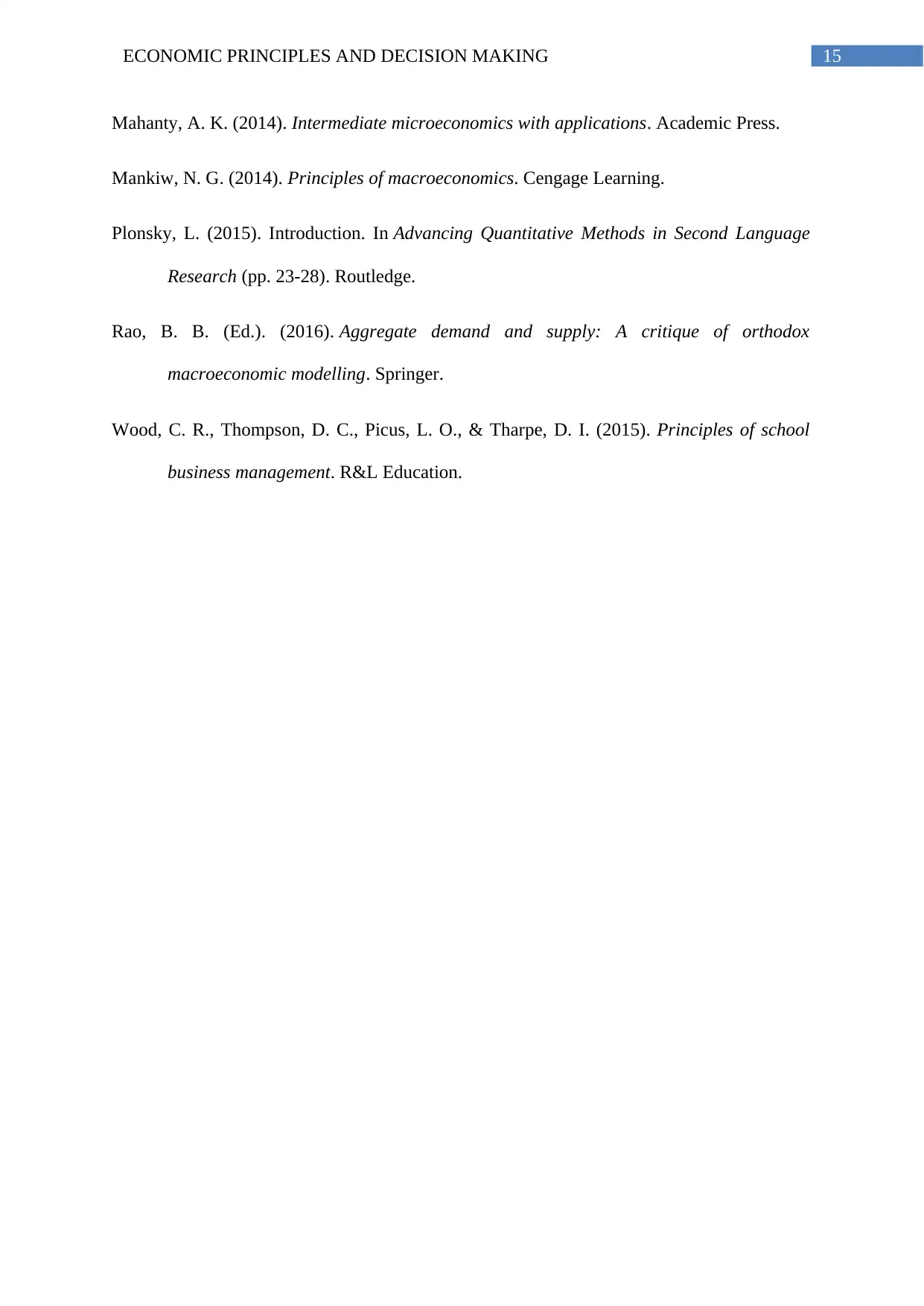
15ECONOMIC PRINCIPLES AND DECISION MAKING
Mahanty, A. K. (2014). Intermediate microeconomics with applications. Academic Press.
Mankiw, N. G. (2014). Principles of macroeconomics. Cengage Learning.
Plonsky, L. (2015). Introduction. In Advancing Quantitative Methods in Second Language
Research (pp. 23-28). Routledge.
Rao, B. B. (Ed.). (2016). Aggregate demand and supply: A critique of orthodox
macroeconomic modelling. Springer.
Wood, C. R., Thompson, D. C., Picus, L. O., & Tharpe, D. I. (2015). Principles of school
business management. R&L Education.
Mahanty, A. K. (2014). Intermediate microeconomics with applications. Academic Press.
Mankiw, N. G. (2014). Principles of macroeconomics. Cengage Learning.
Plonsky, L. (2015). Introduction. In Advancing Quantitative Methods in Second Language
Research (pp. 23-28). Routledge.
Rao, B. B. (Ed.). (2016). Aggregate demand and supply: A critique of orthodox
macroeconomic modelling. Springer.
Wood, C. R., Thompson, D. C., Picus, L. O., & Tharpe, D. I. (2015). Principles of school
business management. R&L Education.
1 out of 16
Related Documents
Your All-in-One AI-Powered Toolkit for Academic Success.
+13062052269
info@desklib.com
Available 24*7 on WhatsApp / Email
![[object Object]](/_next/static/media/star-bottom.7253800d.svg)
Unlock your academic potential
© 2024 | Zucol Services PVT LTD | All rights reserved.





